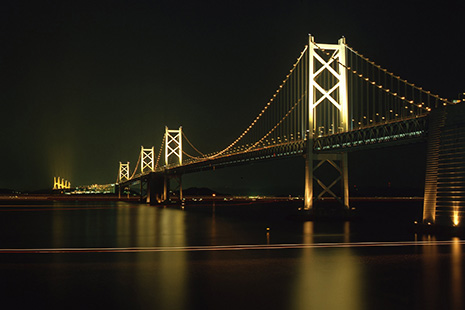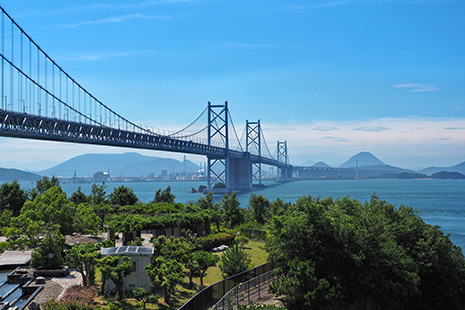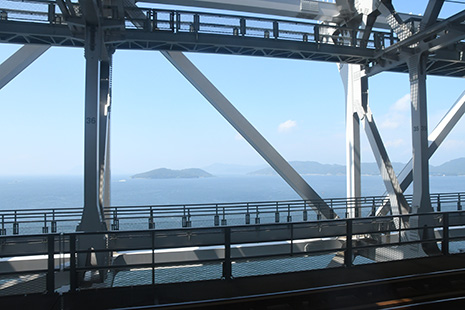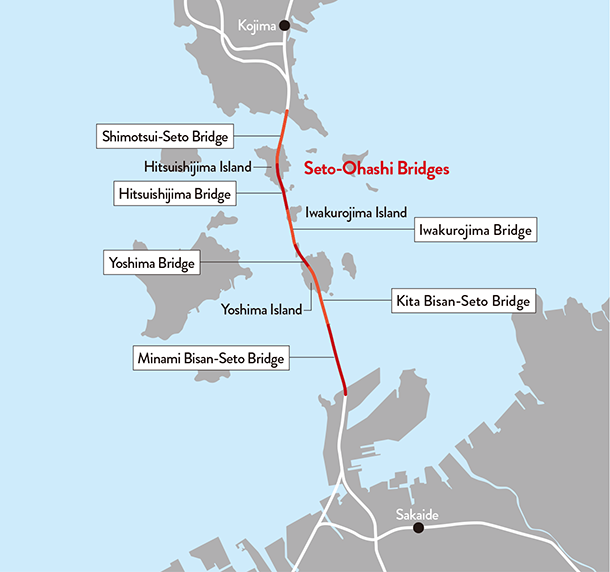March 2024
- English
- 日本語
Seto-Ohashi Bridges — The Dream Bridge That Connects Honshu with Shikoku
-

Shimotsui-Seto Bridge, spanning from Mt. Washu to Hitsuishijima Island
Photo: Hon-Shi Expressway Ltd. -

View of Hitsuishijima Bridge(This bridge and Iwakurojima Bridge are known as "twins.")
Photo: Hon-Shi Expressway Ltd.
-

The illuminated Minami Bisan-Seto Bridge
Photo: Hon-Shi Expressway -

A panoramic view of the bridge from the observatory at the Yoshima Parking Area -

A view from a railroad car running on Seto-Ohashi Bridges. -

Seto-Ohashi Bridges as seen from the pedestrian/bicycle path, Kaze no Michi("path of the wind" in Japanese).
Photo: Kurashiki City Tourism Council

Photo: Hon-Shi Expressway Ltd.
There are currently three crossing routes for the bridges that connect Honshu, the main island of Japan and Shikoku, but the first of these to open was Seto-Ohashi Bridges, which has six bridges and is part of the route between Kojima in Okayama Prefecture and Sakaide in Kagawa Prefecture.

Fujita Kenji, a spokesman for Honshu-Shikoku Bridge Expressway Company Limited (hereafter "Hon-Shi Expressway Ltd."), explains. "A long-held dream of the people living in the Seto Inland Sea region was to build a bridge across the Seto Inland Sea to connect Honshu and Shikoku."
"Construction of Seto-Ohashi Bridges began in 1978, and it took nine and a half years to complete. It consists of three suspension bridges and three elevated bridges. Its most distinctive feature is the two-tiered structure, which holds a motorway on top and a railroad on the bottom. It was recognized by Guinness World Records in 2015 as the world's longest* bridge system for combined use of road and rail traffic."

Photo: Hon-Shi Expressway Ltd.
Since the suspension bridges and cable-stayed bridges** that make up Seto Ohashi Bridge were in danger of swaying or bending due to the running of heavy trains, as well as typhoons and earthquakes, their strength was tested and verified repeatedly.
"We carried out tests on a large model of the bridge and designed it to be able to withstand a large-scale natural disaster. There was also a risk that a train running on it could make bridge girders expand or contract significantly at the abutments, or bend and cause a derailment. To reduce this risk, 'buffer girders,' which ease girder stretching and bending, were developed and installed."
The foundation of the bridge (abutments and bridge piers) had to be built on solid underwater bedrock, and the cables used to hold the bridge were forged by bundling together 30,000 5mm-thick wires. Much of the construction work was on a scale never seen before, making the project extremely difficult to complete.

Photo: Hon-Shi Expressway
"Seto-Ohashi Bridges was designed and built to last over 100 years using the bridge technology at the time, but these days we carry out detailed preventive maintenance, with minute inspections, servicing, and repairs carried out on a daily basis, aiming to ensure a service life of 200 years or longer."
Fujita recommends one place in particular for viewing the bridge with the hope to be passed on to the next generation.
"The view from the observatory at the Yoshima Parking Area, which is located on an island near the midpoint of the bridge, is amazing. There you can feel the presence of the huge Seto-Ohashi Bridges looming over the blue waters of the Seto Inland Sea area. I hope everyone will come and experience it for themselves."

It's nice to enjoy a drive on Seto-Ohashi Bridges by car, but crossing it on a train also has its charm. The Seto-Ohashi Line (West Japan Railway Company and Shikoku Railway Company) runs from Okayama Station (in Okayama City), which is also a Shinkansen stop, to Takamatsu Station in Takamatsu City, the central city of Kagawa Prefecture. From atop Seto-Ohashi Bridges, train riders can enjoy a spectacular view of the Seto Inland Sea, dotted with islands, in the distance. Some say that the view of the Seto Inland Sea is as if you are looking at it while flying through the sky. According to Mr. Fujita, "If your timing is good, you might see the Anpanman Torokko*** trolley train that crosses the bridge."

In Kurashiki City, Okayama Prefecture, Kaze no Michi, a 6.3-km pedestrian and bicycle path offers spots where visitors can see Seto-Ohashi Bridges up close.

Photo: Kurashiki City Tourism Council
If you have a chance, we hope you'll get to enjoy Seto-Ohashi Bridges in various ways.
* The Guinness World Record certificate states 12.3 km.
** A type of bridge distinguished by a structure in which cables strung diagonally from towers are directly connected to bridge girders for support.
*** A special train decorated with popular children's characters, Anpanman and others that runs across Seto-Ohashi Bridges between Okayama and Kotohira, and between Okayama and Takamatsu.

